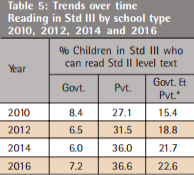
Less Than 10% Of 3rd Standard UP Students Can Cope With Classroom Teaching: 2016 ASER Survey
20 Jan 2017 11:11 AM GMT
Editor : Pooja Chaudhuri
The only fiction I enjoy is in books and movies.
Recent survey by ASER shows the poor condition of rural education in the State of Uttar Pradesh.
The promotion of a student in India is based on the assumption that the child has “completed” the previous standard and is now ready for the next level of education. Thus, it is a given that a Std. III student comes equipped with the prerequisite knowledge, skills and proficiency required to cope with the class’ curriculum. However, the reality in the highest populated State of India, Uttar Pradesh, is quite different, according to the 11th edition of ASER 2016 survey of education in rural India.
In an average Std. III classroom in Uttar Pradesh, less than 10% (1 in 10) children can fluently read simple text. The percentage of children who struggle with recognising letters stands at an overwhelming 68% and approximately 7 out 10 children in the State cannot even read simple Hindi words used in everyday dialogue. ASER compares this data with Himachal Pradesh – the State leading the learning spectrum – and shows that almost half of all Std. III students in Himachal Pradesh are at grade level and only 20% struggle with recognising letters.
The efficacy of Std. III textbooks to teach Std. III children in Uttar Pradesh performs so poorly that almost everyone is left behind. Less than 1 in 10 (7%) Std. III students in Uttar Pradesh government schools can cope with the knowledge imparted to them in the classroom.
The percentage of Std. III children who can read Std. II level text is a low 22.5%, in contrast to 47% in Himachal Pradesh and 46.1% in Haryana. The proportion of children who can at least do subtraction is 23.2% in Uttar Pradesh, whereas 57.4% children in Himachal Pradesh and 54.7 % children in Haryana can subtract.
In the State govt. schools, the percentage of Std. III children who can read Std. II level text has decreased from 8.4 in 2010 to 7.2 in 2016. Private schools have shown improvement from 27.1% in 2010 to 36.6% in 2016. However, when this figure is compared with the 36% of children in 2015, there is only a 0.6% improvement.
As the data progresses, the state of rural education in Uttar Pradesh deteriorates. 16.8% Std. 3 children cannot even read a letter, 15.7% cannot read words and 15.1% cannot read Std. 1 level text.
The performance of children in mathematics also fares poorly. 11.7% children cannot even recognise numbers between 1-9, 36.5% can recognize numbers up to 9 but cannot recognize numbers up to 99 or higher. The proportion of children who can do subtraction in Std. III has declined from 16.5% in 2010 to 7.9% in 2016 for govt. schools.
At the all India level, enrolment in schools increased for all age groups between 2014-16, however the percentage of out-of-schools students in Uttar Pradesh increased from 4.9% to 5.3%. The proportion of out-of-school girls also remains the highest in the State – 9.9%. In the 6-14 age group, children not enrolled in schools in Uttar Pradesh has increased since 2014.
With the States’ assembly elections around the corner, the Uttar Pradesh government needs to rethink and redesign its rural education strategy. Clearly, students are not making progress through the traditional classroom teaching method. The system which assumes that a child has understood and knows everything learnt in the lower standards before he is promoted to the next higher standard needs to be changed. According to the ASER survey, in States like Uttar Pradesh where learning levels are low, improvement is possible. The Indian government needs to keep an open mind in order to achieve that.
 All section
All section
















